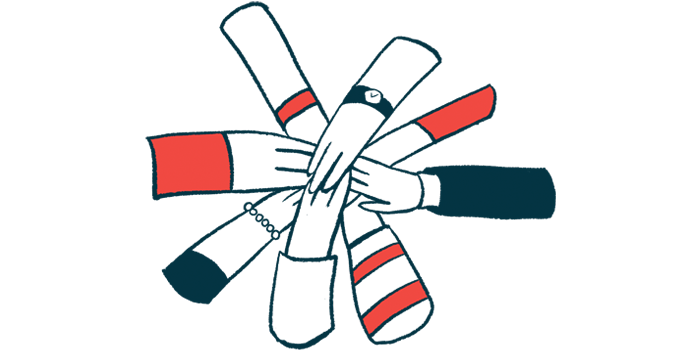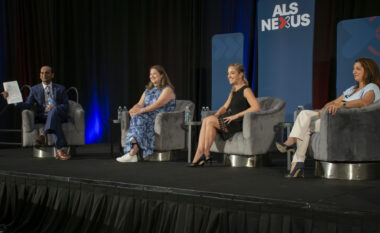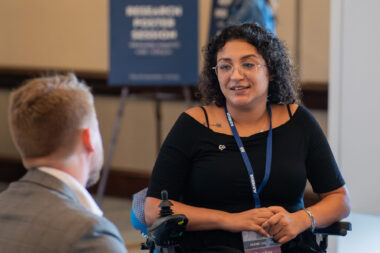This year’s ALS Nexus conference celebrated progress, shared hope
Having stakeholders in one room 'creates solidarity,' organizer says

The second edition of ALS Nexus — a conference hosted earlier this month in Dallas by the ALS Association — brought together people from across the amyotrophic lateral sclerosis (ALS) community to connect with each other, celebrate recent advances, and share hope for the future.
“What really drives us to hold Nexus each year is the ALS community itself,” Candyl Eyster, director of communications at the ALS Association, said in a written interview with ALS News Today. “The most meaningful thing to come out of this conference isn’t just the sessions or presentations, it’s the connection.”
ALS Nexus is a yearly event that brings together people living with ALS, caregivers, clinicians, researchers, and advocates. According to Eyster, having all these different stakeholders in one room “creates solidarity and a shared set of values.”
“Nexus helps connect the dots between the people diagnosing ALS and those being diagnosed, between caregivers and clinicians, between researchers and advocates,” Eyster said. “That exchange of expertise and lived experience doesn’t just fuel progress in a broad sense; it sparks collaboration, new ideas, and solutions that can only come from being all together. It reminds us all that while new treatments are critical, so is the community that carries this fight forward.”
The congress featured talks on research advances and ongoing studies, as well as discussions about strategies for navigating life with ALS.
Finding ways to navigate the ALS journey – together
“The conversations on navigating life with ALS were some of the most powerful moments of Nexus. They weren’t just about science or care models — they were about real, day-to-day life challenges and insights,” Eyster said. “Attendees shared openly about finding hope, coping with burnout, staying connected socially, and the role of movement and nutrition.”
“What stood out is that while ALS changes so much, people are still finding ways to live fully, to laugh, to connect, and to keep hope alive,” she added. “The message is really that no one should face ALS alone, and that we and other ALS partners have resources, strategies, and communities ready to walk alongside families at every step.”

ALS Nexus featured panel discussions and workshops. (Courtesy of the ALS Association)
Across all the conference’s events, a major topic of discussion was the amount of progress in ALS research that’s been made in recent years, according to Rich Brennan, the ALS Association’s vice president of federal affairs.
“In fact, if you were to pull a thread from all of the sessions at ALS Nexus, the topic of the progress made in ALS research was preeminent,” Brennan said.
Among advances in just the last decade, the U.S. Food and Drug Administration (FDA) in 2017 approved Radicava (edaravone) as the first new treatment for ALS since the 1990s. Then, in 2023, the FDA conditionally approved Qalsody (tofersen) for ALS associated with mutations in the SOD1 gene.
A lot more ALS research is now ongoing. Kuldip Dave, PhD, senior vice president of research at the ALS Association, said some of the most exciting up-and-coming research focuses on TDP-43, a protein that forms toxic clumps in nerve cells in the vast majority of ALS patients.
“TDP-43 is the protein that accumulates in approximately 97% of people with ALS, making this pathway the most direct way we can go after the many different forms of this disease,” Dave said. “From what I saw and heard at ALS Nexus, I’m really encouraged by the progress the community is making to better understand and target proteins both upstream and downstream of TDP-43 and excited by the impact this could have on people living with ALS in the future.”
‘It’s going to take all of us.’
Brennan noted that much of the progress made in ALS research, including work that helped develop Radicava and Qalsody, has been funded by grants from the U.S. federal government. Now, policy changes aiming to limit federal spending are jeopardizing many research efforts, which may hinder future progress.
“These advancements underscore the real-life impact of sustained federal investment in ALS research and the urgent need to maintain momentum toward making ALS a livable disease. But this progress is now at risk,” Brennan said, highlighting proposed cuts to programs like the ALS Research Program at the Department of Defense and the National ALS Registry at the Centers for Disease Control and Prevention (CDC). According to Brennan, losing these programs “would not just slow progress — it could set us back decades.”

Participants are seen chatting during ALS Nexus. (Courtesy of the ALS Association)
Brennan urged the ALS community to continue advocating for the government to invest in ALS research, noting that the Senate Appropriations Committee recently recommended “strong support” for ALS research in next year’s budget.
“Advocacy works. Thanks to persistent outreach from the ALS community, Congress is beginning to recognize the importance of sustaining funding,” Brennan said, noting that the ALS Association’s website offers advocacy resources, including action alerts.
“More work needs to be done,” Brennan said. “To protect the future of ALS research and move us closer to making ALS livable until we cure it — it’s going to take all of us.”
Building on the foundation of the first ALS Nexus conference
According to Eyster, the first ALS Nexus showed “what was possible when we brought the entire ALS community together.”
“This year built on that foundation in a big way. We had more participants, more interactive opportunities, and even stronger representation from people living with ALS. We expanded sessions on technology, care, and daily life with ALS,” she added.

Mikey Stone and Frankie Torres performed “Losing to the Letters” during ALS Nexus. (Courtesy of the ALS Association)
“And then there were those unforgettable moments you can’t plan for,” Eyster said, noting that one of the most powerful moments was when Mikey Stone, a music producer who lives with ALS, and Frankie Torres, who lost her father to ALS, premiered their song “Losing to the Letters.”
“It filled the room and evening with both hope and determination,” Eyster said.
With this year’s conference now in the rearview, the ALS Association is already gearing up for ALS Nexus 2026, which is set to be held Aug. 23-26, 2026, in Orlando, Florida. Community members can sign up to receive conference updates online.
“We have already begun planning and we welcome feedback and ideas on how Nexus can continue to grow,” Eyster said. “The more voices we include, the more meaningful and valuable this conference will be for everyone in the ALS community.”









